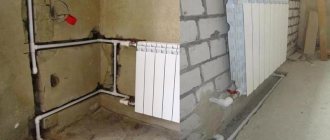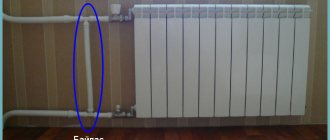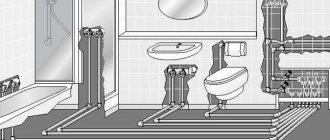How to move a gas pipe in an apartment: transfer rules and location tips
The installation of gas communications in an apartment is subject to certain requirements, therefore, independent installation and connection of equipment, as well as moving the gas pipe to another place, is strictly prohibited.
All issues regarding the laying of internal and external gas pipelines are resolved by the gas service, without whose permission it is only possible to move the stove a limited distance.
We will tell you how to obtain approval for replacing a gas pipeline, and also describe the technology for moving an intra-apartment pipeline. The proposed instructions are not a guide to action; all work must be carried out by a representative of the gas service.
Move the gas pipe in the apartment and on the property: how to do it correctly
It is impossible to imagine a modern apartment or private house without the benefits of civilization. Gas is one of them. It is supplied to housing through pipes stretched from the central main line. The reasons for relocating such utilities may be different, but in any case, doing this yourself is strictly prohibited. The work must be carried out by employees of specialized structures who are authorized to provide services of this type.
The need to move gas pipes may arise for various reasons, but you cannot carry out such work yourself
Reasons for moving gas pipes in the kitchen
All work on moving and replacing metal pipes, especially those requiring welding, is carried out by representatives of Gorgaz or another authorized organization. Having received an application from residents, they are always interested in the reasons for the planned transformations.
Most often, it is necessary to change the piping in the kitchen without changing the layout or moving equipment to other rooms.
The reasons may be different:
- replacing old equipment - purchasing a gas water heater, stove or boiler - which requires a little more space;
- major renovation in the kitchen;
- moving the gas stove from the window 0.5-2 m towards the sink;
- changing the installation location of the gas meter;
- moving a horizontal pipe from a great height under a table top, etc.
Often, the relocation of pipes is required in new buildings, where the original location of significant kitchen objects defies logic and explanation: suppose, if in a 15-meter kitchen the gas stove is located near the window, the sink is in the opposite corner, and the hood is on the other side, above the entrance to the kitchen.
We have to correct the design mistakes and move the stove closer to the sink so that food can be cooked in comfortable conditions.
The most common reason is the purchase of a new kitchen set with built-in equipment (oven and hob). In this case, the pipes need to be either shortened or lengthened, depending on the planned installation location of the devices.
If you want to find out how best to move a gas pipe in an apartment with redevelopment, we recommend contacting a design organization to draw up a transfer plan.
The fact is that in typical city apartments it is prohibited to reinstall risers, pipes, as well as any gas equipment in living rooms, and even to combine a kitchen and a room, permission is also required.
Rules for operating gas pipes
There are a number of requirements for gas pipes installed in the kitchen, compliance with which ensures the safe operation of all appliances that use gas (this mainly applies to gas stoves).
The rules for using gas stoves in the kitchen are as follows:
- The minimum ceiling height required to install a gas stove is 2.2 meters (in the case of sloping ceilings, this rule must also be observed, so you will have to look for a place with a suitable height);
- The kitchen must have an opening window so that, if necessary, repairs to the gas pipeline can be carried out during the daytime without turning on the lighting (however, a separate ventilation system would not be superfluous in the kitchen);
- The distance from the slab to the opposite wall cannot be less than 1 meter;
- All kitchen surfaces made of flammable materials must be covered with a layer of plaster to prevent fire;
- You can use the stove only if the kitchen is located separately from the corridor and is separated from it by a door;
- Gas pipes in the kitchen are routed in such a way that there is a distance of more than 7 cm between the stove and the walls;
- The gas pipeline can be connected to the stove only at the height where there is a connecting fitting;
- The tap that allows you to turn off the gas should be located at a height of 1.5 meters from the floor level and 20 cm from the stove;
- When installing the stove, you can use heat-resistant flexible hoses, which are changed in accordance with the recommendations described in the documentation attached to the product.
These rules, by and large, relate to connecting gas equipment to an already installed pipeline. However, if there is a need to move a gas pipe, then these rules will still come in handy to plan the further location of objects in the kitchen. We will talk further about how to move pipes in the kitchen.
Obtaining approval for gas pipeline replacement
Whether a transfer is possible or not can only be decided by authorized bodies, that is, the gas service of your city (district). Only a qualified specialist has the right to carry out any dismantling and installation work. Of course, pipes cannot be moved without approval.
The permit is issued in the following sequence:
- Find out the contact details of the gas service at the place of registration, contact specialists, explain the situation, and consult.
- You draw up an application (using a standard form) that will “launch” the approval process.
- Based on your application, a gas service representative will arrive at your home. The time will be confirmed in advance.
- The specialist performs an inspection, listens to wishes, and answers questions. Often at this stage it is necessary to change plans, since the desired transfer does not meet safety requirements (a preliminary study of the gas pipeline installation standards will eliminate this unpleasant moment).
- Approval of the final transfer scheme, drawing up an estimate. All documents are prepared by the organization providing the services. No work will be carried out without the consent of the property owner.
- If the transfer conditions are met, pay for the service using a receipt and agree on the start time of the work.
The approval procedure usually takes several days; it can drag on for a long period for only one reason: if the property owners and representatives of the gas service have not found a compromise solution.
How to move a gas pipe in the kitchen
So, you received a positive answer to the question of whether it is possible to move a gas pipe in the kitchen and waited for the specialists to arrive. They must perform this work in the following sequence:
- Use the valve to shut off the gas flow into the stove.
- Blow out the disconnected part of the gas pipeline using any available method. For this purpose, you can use a vacuum cleaner in the “blow” mode. This will remove any remaining gas from the pipe.
- Use a grinder to cut off the unnecessary segment of the gas pipe, and simply weld the hole formed after this operation.
- Make a new hole in the supply pipe and weld a piece of metal pipe to it, which will serve as a drain.
- The final stage of transferring the gas pipe to the kitchen involves installing a valve directly on this outlet, from which, in turn, an outlet is made to the stove using a threaded connection.
General requirements and standards
To ensure that the approval process goes smoothly, it is better to familiarize yourself in advance with the basic provisions for installing a gas system in residential premises. As a cheat sheet, you can use the regulatory document - SNiP 2.04.08-87* (current version).
If the walls and ceiling consist of flammable materials (wood), they must be plastered or lined with metal sheets.
Gas pipes are used to transport fuel to consumers - stoves, ovens, columns, so the location of the equipment is no less important than the pipe layout.
Source
Step-by-step instructions: how to move a gas pipe in the kitchen
If everything went well with the approval of the plan and transfer of the estimate, you can expect the arrival of craftsmen to carry out work to change the location of the gas pipe.
In order for the work to be done quickly and efficiently, you need to prepare:
- Contact specialists in advance and find out if you will need any consumables (by the way, when buying long hoses yourself, you should pay attention to their diameter and length, since if they turn out to be too long, it will be impossible to shorten them in accordance with the technology works);
- Clear the room where it is planned to replace and install pipes - access to the network must be free;
- It is better to cover all existing furniture and household appliances with some kind of non-flammable materials to protect items from dust and debris;
- Before the technicians arrive, turn off the gas and take meter readings.
You should not carry out such work yourself; it is better to trust them to professionals. But for general information, you can find out how the process of installing pipes in a new place occurs.
Work order:
- After shutting off the pipes, the entire system is purged to remove any existing debris;
- Excess elements of the system are cut out, and a plug is placed in the hole that appears;
- After this, a hole is cut where the new pipe will be;
- Next, welding of pipes and installation of taps begins;
- All joints are sealed with tow;
- The device is connected to the network.
After completing these works, it remains to check their quality.
Under no circumstances should you check for a gas leak by holding a lit lighter or match to the connections, otherwise the entire house may explode!
To check for leaks, you need to prepare a solution of soap and water, which you need to apply with a brush to the pipes and connecting places. Bubbles will appear where gas leaks out. If everything is in order, all you have to do is wait until the pipes dry and coat them with paint to avoid metal corrosion.
By the way, if you are denied the transfer of the gas system, do not be upset. As a last resort, you can buy a beautiful box for pipes and hide them there, giving the room an aesthetic appearance.
Gas pipes in the kitchen: is it possible to redo the supply to the stove?
This article is an attempt to clearly explain what a resident of an apartment building can do with his own hands with the internal gas pipeline in his apartment. I will pay attention to the restrictions set out in the regulatory documentation and talk about my own practical experience regarding how and with what you can move the gas pipe in the kitchen. So, let's go.
The gas distribution makes it difficult to move the stove and hang cabinets. The desire to remake it is quite natural.
An example of work in the kitchen to move a branch of a gas pipe under the countertop:
Before moving the gas pipe, the tap was at a height of 1.5 m from the floor. When planning the kitchen, the gas outlet with the tap ended up in the wrong place.
After moving the gas pipe, the tap is located at a height of 78 cm from the floor, which complies with SNiP standards and is placed under the countertop.
Tip: If you decide to move the gas pipe in the kitchen under the countertop, when developing a kitchen project, immediately think about where to place the gas tap! The gas tap should not be located in the washing area, in the drawer in which household appliances are located. It is necessary to choose a free box with a width of at least 30-40 cm, in which case there will be no problems with the location of the gas tap.
Hands off!
First, about the prohibitions. Yes, dear reader, I have no doubt that you are full of enthusiasm and are eager to carry out the transfer of the gas pipe in the kitchen yourself. However, please take the restrictions I have listed as seriously as possible:
- You cannot move the gas riser in the kitchen. All you can do is change where the tap attaches to it or the length of that tap;
Relocation of the riser requires mandatory calculation and approval. Usually it is refused.
- You cannot use polyethylene or plastic pipes indoors . SNiP 2.04.08-87 in paragraph 4.85 directly states that polyethylene is prohibited for laying in residential buildings, and in paragraph 6.2 it states what materials should be used;
Excerpt from SNiP: gas pipelines made of steel pipes should be installed inside buildings and structures. To connect gas appliances, it is permissible to use rubber or rubber-fabric hoses (read: reinforced gas hoses). However, it is still recommended to use hard eyeliners.
- Do not close general plug valves, ball valves and valves on gas supply inlets and risers . If at the time you turn off the gas, someone is cooking food, the fire will go out, and after starting it will continue to flow into the kitchen. The result of such a development of events is usually described in TV reports by random witnesses: there is no one among the residents to tell about it;
Captain Obviousness suggests: for any work related to disconnecting the riser and carried out by gas service specialists, it is necessary that the residents of all apartments be at home. When launched, all residents are notified about it personally.
The gas taps in the entrance must not be touched. Categorically.
- Finally, the main thing: PB (safety rules) 12-368-00 prohibit any gas-hazardous work carried out by persons who have not undergone instructions and exams on safe work methods .
Simply put: only a representative of Gorgaz or a licensed gas equipment servicing company should connect any gas appliances.
What will happen
If you are incredibly lucky and, without the necessary knowledge and practical experience, prevent a gas leak, your amateurishness will be revealed during the first scheduled inspection of gas equipment by representatives of the gas service.
The consequences are unpredictable: they can either turn a blind eye to the work you have done or draw up a report on an administrative offense that endangered the life and health of people.
Worst case scenario... Comrades, I won’t spoil your mood. Everyone knows what a gas explosion in a residential building is.
Gas pipe in the kitchen: norms, rules, requirements
All work on moving and replacing metal pipes, especially those requiring welding, is carried out by representatives of Gorgaz or another authorized organization.
Having received an application from residents, they are always interested in the reasons for the planned transformations. Most often, it is necessary to change the piping in the kitchen without changing the layout or moving equipment to other rooms.
The reasons may be different:
- replacing old equipment - purchasing a gas water heater, stove or boiler - which requires a little more space;
- major renovation in the kitchen;
- moving the gas stove from the window 0.5-2 m towards the sink;
- changing the installation location of the gas meter;
- moving a horizontal pipe from a great height under a table top, etc.
Often, the relocation of pipes is required in new buildings, where the original location of significant kitchen objects defies logic and explanation: suppose, if in a 15-meter kitchen the gas stove is located near the window, the sink is in the opposite corner, and the hood is on the other side, above the entrance to the kitchen.
We have to correct the design mistakes and move the stove closer to the sink so that food can be cooked in comfortable conditions.
It is strictly forbidden to carry out work to move the gas riser. The only change allowed is to disguise the pipes with easily dismantled structures, for example, wall-mounted kitchen cabinets
The most common reason is the purchase of a new kitchen set with built-in equipment (oven and hob). In this case, the pipes need to be either shortened or lengthened, depending on the planned installation location of the devices.
If you want to find out how best to move a gas pipe in an apartment with redevelopment, we recommend contacting a design organization to draw up a transfer plan.
The fact is that in typical city apartments it is prohibited to reinstall risers, pipes, as well as any gas equipment in living rooms, and even to combine a kitchen and a room, permission is also required.
Hello, dear readers. If there is a gas pipe in the kitchen, special standards apply to it. This includes distances from surfaces and from household appliances. Proper installation of gas pipes throughout the apartment is also important.
The gas pipeline is installed in the apartment according to a previously developed plan. But even before this, it is necessary to determine the operating conditions of the gas pipeline. So, if gas units operate in the kitchen, it will become a mandatory element for them. Its presence in the boiler room is the key to warmth throughout the house.
For the positions of the gas pipe in the kitchen and apartment, the standards are as follows:
- No installation in residential areas or ventilation shafts.
- Intersection with openings for windows and doors is unacceptable.
- Laying in hard-to-reach areas is prohibited. For example, behind designer decoration on the wall. Gas equipment must be provided with quick and easy access in case of malfunctions.
- The minimum distance of the gas pipe from the floor is 2 m.
- When using thin-walled pipes, the length of flexible communication components should not exceed 3 m. The density of connections of network elements is also of great importance.
- Installation is permitted only in those rooms where the minimum ceiling height is 220 cm. And these rooms must be well ventilated.
- The kitchen should not be provided with ventilation affecting the living areas.
- Wall and ceiling surfaces close to gas appliances must have a special coating of non-combustible plaster. If there is no such coating on the wall, it must be insulated from gas appliances using a metal sheet. Its suitable density is 3 mm.
To lay a gas pipe in the kitchen of a private house, you also need to know the standards. To begin with, gasification here begins with notification of the local gas organization and the planned work. It provides a technological condition that determines the algorithm for constructing a gas pipeline. The technical issue is being resolved. A personal development for gasification of a certain area is created. Also, a warrant for the installation of a gas pipeline is issued by the traffic police.
If neighboring houses are already provided with gas, you only need to connect the pipes in a specific area to the main network. The working pressure factor is also important here. Its parameter in the main pipes determines the choice of pipes to pass into the house.
The preferred gas source determines the gas supply technology: centralized or autonomous.
Gas pipelines can also run to private homes underground or above it.
And the standards for installing pipes to the kitchen in a private house are identical to the points in the housing issue.
Installation standards
The rules and regulations for installing a gas pipe in the kitchen are as follows:
- Before work, close the main valve.
- The gas pipeline is purged if the pipe is moved.
- The pipe is secured to the wall. These are special clamps and brackets.
The type of fastener is determined by the length and diameter of the pipes.
- If there are electrical cables near the pipes, then the minimum distance here should be 25 cm. And gas equipment is 50 cm away from the electrical panel.
- Location near cooling equipment is unacceptable. In this matter, owners often make mistakes. Is it possible to place a refrigerator near a gas pipe? It is forbidden. So the refrigerator radiator can quickly overheat, and the device itself will become faulty.
- The minimum distance from the gas pipe to the stove is formed as follows: the branch to it goes only along the line of the connecting fitting. The shut-off valve is placed 150 cm from the floor and 20 cm from the side of the stove. The slab is installed using a heat-resistant flexible hose.
- Work should be carried out in a room with stable ventilation and natural light.
- The minimum ceiling height is 220 cm.
- The slab and the opposite wall must be separated by at least 100 cm.
- The surfaces around the pipes and slabs are covered with fire-resistant material - plaster.
- The pipes are routed so that the slab is 7-8 cm from the walls.
- The stove is used only in a kitchen that has a fence from the corridor: a wall or partition and a door.
- The height of the gas pipe from the floor is at least 2 m.
Another important aspect is the maximum length of certified gas hoses. In Russia it has no restrictions. In Europe it is 2 m. We can have products from 2 to 10 m or more. It all depends on the owners’ tasks and working conditions.
Transfer Aspects
When a gas pipe is in the way in the kitchen, it can be moved or disguised. In the first case, you must strictly comply with the regulatory requirements for moving the gas pipe in the kitchen.
The maximum length of flexible elements is 3 m.
The norm for a gas pipe in the kitchen in height from the floor is 2 m (minimum).
The connection areas must be rigid.
The pipeline itself should be painted.
The areas where the system intersects with the walls are “packed” - a special case is used.
Read more: Dimensions of plastic pipes for water supply table - Heating
When working on a gas transfer network, block the gas before working.
You need to decide on your tasks. It is better to designate them schematically and show them to specialists.
And the decision to cut or move a pipe in the kitchen is the prerogative of special services. The owner can only indicate his plan. And the masters can approve or prohibit it. They will tell you what the price of such an update is, where it is better to start and who to contact.
The algorithm of actions in solving these problems is as follows:
- Contacting the gas company at the registration area. Create a statement about the desired changes.
- Based on the application, specialists arrive. They inspect the conditions, carry out checks and make the necessary calculations so as not to violate the norms for the location of the gas pipe in the kitchen.
- Creating an estimate. When the finished plan is in the hands of the customer, other formalities are settled, the client pays for the service. If necessary, the plan is modified.
If the work according to the customer’s scenario is not safe, or the estimate does not suit him, he can disguise the pipe. For example, purchase a special elegant box
If there are no dilemmas with the estimate, then within 5 days of its approval, craftsmen arrive to the customer. Before their visit, the client can:
- Contact them and find out if they need any consumables and resolve this issue immediately,
- Clear the area for dismantling old products and installing new ones. Workers should not have problems accessing the network.
- Protect all valuables, kitchen appliances and surfaces. A tarpaulin or similar materials are used for protection. After all, the work ahead is very dusty.
- The valve is blocked. Gas should not flow to the pipes during this period. It is easier to connect components using a siphon connection.
The work itself goes like this:
- To remove residual gas and debris, the pipes are purged (after the gas is blocked).
- The unnecessary component of the system is removed.
- The resulting hole is plugged.
- A hole is made at the location where the new element is installed.
- The new structure and other elements are welded here, if they are included in the project.
- The crane is being installed. The connecting areas are sealed with tow.
- The stove is connected. The standard is observed at what distance from the gas pipe the stove can be placed. This aspect has already been discussed here (the tap is at the level of the connecting fitting, the minimum distance from the side of the slab is 20 cm). With the upper variation of the wiring, the shut-off valve is placed at the lower end of the gas appliance. Distance from the floor: 150-160 cm. The gas riser is at least 20 cm away from the tap.
- A work completion certificate is generated and signed.
The question of camouflage
Is it possible to hide a gas pipe when there is no way to move it? It is possible and necessary. Special boxes are available for sale.
You can come up with your own plan on how to hide the gas pipe, and at the same time the counter in the kitchen.
If you have absolutely no idea how to do this effectively and harmoniously, look at the photo “How to hide gas pipes in the kitchen?”
Conclusion
It is necessary to install gas pipes in the apartment and in particular in the kitchen in accordance with current regulations. This is both compliance with the law and a guarantee of your safety.
Most of the goodies on the tables appear with the help of a natural gift - gas. Naturally, the owners of the house want blue fuel to enter the kitchen unnoticed, without destroying the harmony, integrity of design and style, which has been thought out for months. Meanwhile, utility networks are not a toy, you cannot joke with them, because in the pursuit of beauty you can lose the main thing - life. So, how and where should a gas pipe be installed in the kitchen: norms and rules for handling the system.
Just shhh
My further recommendations are somewhat akin to the “bad advice” of Grigory Oster: I am going to talk about what, strictly speaking, should not be done. However, alas, we live in a real and far from perfect world.
So, what to do if you still really can’t wait to move the gas stove or shorten the gas pipe outlet?
Theory
No, no, mon ami, don’t rush to pick up the keys and hacksaw. First, a little tedious, but necessary to familiarize yourself with the regulatory requirements.
Yes, yes, I know it's ugly. Let's not rush.
The standards for gas pipes in the kitchen are set out in the document I have already mentioned - SNiP 2.04.08-87.
- Gas distribution in a residential building should be carried out mainly by welding. Threaded and other detachable connections are permissible only at connections to shut-off valves, gas meters and consumer devices;
From a practical point of view, this means for us that the internal gas pipeline in the apartment cannot be assembled from pieces. It’s really not worth climbing to a gas pipeline with welding without being able to completely turn it off. One more nuance: this paragraph of SNiP does not completely prohibit the use of dismountable connections, but only recommends refraining from them.
- All detachable connections must be made in places accessible for inspection and repair. There is no need to hide them in non-dismountable kitchen furniture;
- The gas pipe must be laid, as a rule, openly;
- If there are several gas consumers, shut-off valves must be installed in front of each of them;
- In places where people pass (for example, above a door or in a hallway), the gas pipe must pass at a height of at least 220 centimeters. What the instructions are related to - I think there is no need to explain;
- It is recommended to paint steel internal gas pipelines to protect against corrosion. At the same time, the decor of the gas pipe in the kitchen or hallway must be waterproof.
The paint must protect the gas pipeline from contact with water.
Practice
After the tap
First and foremost: in the vast majority of cases, there is no need to saw or cut anything. To move the slab, it is enough to extend the line between it and the shut-off valve. To hide an untidy steel liner, you can simply build a cabinet around it (of course, collapsible or with wide-opening doors).
How can you connect a stove or other gas appliance without violating the requirements of SNiP?
Corrugated stainless pipe. In this case, the key requirements will be met:
- The supply to the device will be rigid (a corrugated stainless pipe clearly has nothing to do with flexible hoses);
- The wiring will be done with a steel pipe. Who will say that stainless steel is not steel?
Corrugated stainless steel on the connection to the stove.
When corrugated stainless pipe had not yet appeared on the Russian market, I successfully transferred gas stoves with an oxygen or acetylene hose on steel or brass fittings. An aluminum clamp for a screwdriver was used to secure the hose to the fitting.
To transfer the slab, an oxygen hose with fittings was used.
Stainless steel connections are mounted on compression fittings: the pipe is inserted into the fitting with a loosened union nut, after which it is tightened and compresses the pipe with a silicone seal.
Rules for the location of pipes on the site
Gas systems can be laid on a plot of land:
- in the ground. The internal gas pipeline allows you to preserve the usable space of the site and “hide” the main communications;
- on the surface. An external pipeline will be cheaper, but pipes passing through the area limit the space.
When constructing any type of pipeline, it is necessary to comply with the rules for laying pipes, which are established by SNIP 42-01-2002.
Limitations when laying pipes
At what distance from the gas pipe should the foundation of the house be located? The distance from the house to the pipeline depends on the parameters of the communication system, in particular pressure:
- a line with low pressure (no more than 0.05 kgf/cm²), which is typical for pipelines supplying fuel to private consumers, should be located at least 2 m;
- a pipeline with average pressure values (from 0.05 kgf/cm² to 3.0 kgf/cm²), used for laying central systems, can be located at a distance of 4 m;
- The high-pressure pipeline system (up to 6.0 kgf/cm²), supplying gas to enterprises and economic complexes, can only pass at a distance of 7 m or more.
Types of gas pipelines by pressure
The external pipeline cannot pass through:
- at a distance of less than 50 cm from window and door openings;
- at a distance of less than 20 cm to the roof of the room;
Distances to other communications (water supply, sewerage, etc.) are presented in the following table.
Location of disposable pipes relative to other communications
Gas pipeline security zone
In addition to the rules for the location of pipes, when laying a gas pipeline, the presence of a security zone should also be taken into account.
The security zone of a gas pipeline system means the distance between the communication pipe and two conventional lines running parallel on one side and the other.
Depending on the pressure in the gas supply line, the size of the security zone is:
- for low pressure pipelines – 2 m;
- for highways with an average pressure value of 4 m;
- for high pressure pipes – 7 m.
The special zone of the gas supply system can be increased:
- for pipelines made of polyethylene pipes (up to 3 m);
- for highways laid in permafrost conditions (up to 10 m);
- for systems laid under water (up to 100 m);
- for routes laid in a forest belt (up to 3 m).
The size of the security zone is indicated on the information plate installed on the pipeline.
Availability and size of the security zone
Within the security zone it is prohibited:
- construction of any structures;
- arrangement of cesspools;
- arrangement of storage areas for toxic and chemically active compounds;
- installation of fences and other barriers. The minimum distance from the fence is determined by the size of the protected area;
- light a fire;
- cultivate the soil to a depth of more than 30 cm (for underground communications).











